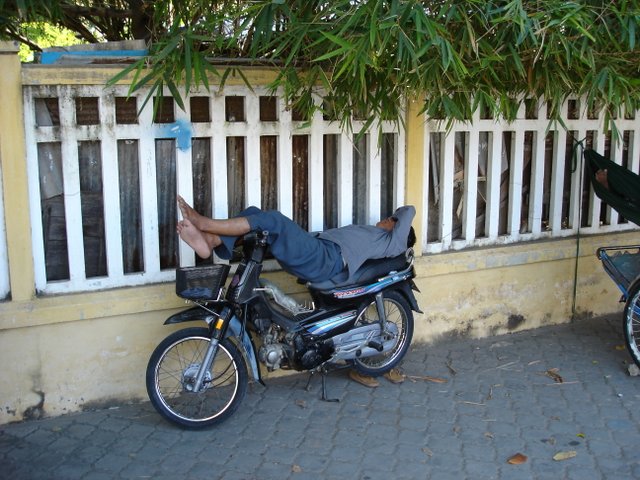November 9, 2007
We checked out of Vietnam, boarded another boat, went a few hundred meters upstream, disembarked again presumably at the other side of the border, handled the formalities, and were welcomed into Cambodia without any further drama. Boarding the boat for the last time, we were finally on our way to Phnom Penh. Well, that’s what we thought anyway. The boat stopped in some backwater village and we all disembarked again. At this point, we were herded into groups by a guy who gave us the impression that he had been a high-ranking official in the Pol Pot regime. He was quite adept at barking orders and flatly ignoring any and all questions. We were jammed like sardines into a Cambodian bus, with seating arrangements designed for people about three-quarters the size of us. All the seats were filled and our luggage was stacked to the ceiling in front, between the passengers and the driver, for what we were told was a 15-minute ride into the middle of Phnom Penh.
We caught a tuk-tuk to the area fronting the Tonle Sap River found a nice and spacious room for one night only with a balcony overlooking the River at the Cozyna Hotel for $30. On the ground floor of the same building, we discovered a very western-looking restaurant where we enjoyed a couple of much-needed cocktails an excellent dinner.
The official currency of Cambodia is the riel, but the US dollar is used everywhere. In fact, we never did find an ATM that dispenses anything but US dollars. It seems that the purpose of the riel is to take the place of coins, as we’ve not seen any US change in use. So if you make a purchase for say, $8.50 and pay with a $10 note, you’ll get a $1 note and two 1000 riel notes which are equal to 50 cents.
November 10
After breakfast at a nearby coffee shop we set out to find another hotel. Rooms fronting the Tonle Sap River vary wildly in price, ranging from less than $10 for a backpacker’s hostel to more than $200 for five-star accommodation. We found another decent room just down the street at the Paragon Hotel. It was nice, immaculately clean but without a river view, and cost $20. I can’t imagine the $200 room could have been ten times as nice!
After shifting hotels, we set out on foot to explore Phnom Penh. Cambodia is clearly a few steps behind Vietnam in its level of development and standard of living. That said, we found interesting the number of very large, nearly new Japanese SUVs and “Yank Tanks” such as Hummers and Cadillac Escalades, with heavily tinted windows, cruising around the city. Of course there are heaps of motorbikes and the ubiquitous tuk-tuks. In Cambodia, tuk-tuks are either a three-wheeler motorbike with a row or two of seating in the back, or a small two-wheeled carriage that is towed by a motorbike with a little trailer hitch behind the seat. Riding the tuk-tuks is cheap, reasonably comfortable and of course they have flow-thru air conditioning.
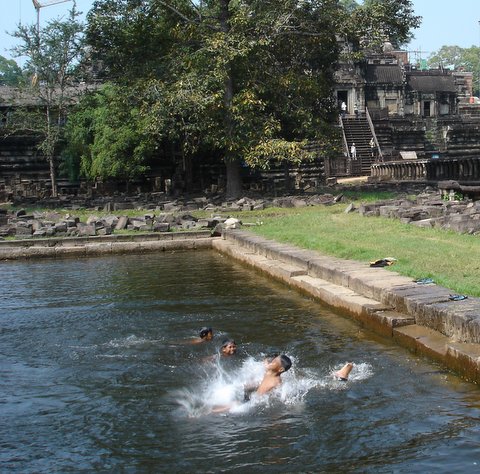 |
| Boys cooling off in a temple pool. |
Phnom Penh has a plethora of pagodas and temples. We walked to the only hill in town where on top, of course, sat a temple. The purpose of the temple was to bring good luck, if not a good view of the city below. The price of admission was $1 for tourists, free for locals – go figure! Protesting this blatant discrimination we gave it a miss and walked around the base of the hill where came upon the sparkling new and very modern US Embassy complex, replete with high fences and armed guards posted around the perimeter. As I lifted my camera to take a photo of this impressive compound, I was informed by one of the guards, a Cambodian, that the taking of photographs was strictly prohibited. I put the camera away, while we laughed to ourselves. I wonder if they posted camera police at the temple up on the hill, or at the rooftop restaurant at the ten-story hotel across the street. Why they built the embassy there, near the only hill in town, is beyond me. I suppose this is just another example of the oxymoronic government intelligence.
We worked our way to the center of town to the main market. It is a huge domed building, with four long halls extending out towards the corners of the large city block on which it is situated. The rest of the city block is covered with sheets of corrugated iron, large umbrellas or tarps covering the makeshift outdoor stalls. We made our way from the street to the central dome through a very odiferous meat and produce section. The main building had nicer stalls and wandering through, we found virtually everything imaginable was on offer.
From there we made our way to the part of the city which looks to me like a “temple and pagoda farm”. There were literally entire city blocks with beautiful and ornate temples and pagodas, all with pointy bits at the top, extending high into the sky. We made our way past the large and ornate royal palace (closed to the public, of course) to the Silver Pagoda. The Silver Pagoda is so named because the floor tiles in the main hall are made of silver. The excesses only just begin at ground level. High up on the altar sits a jade-colored Baccarat crystal Buddha figure. The gold leaf altar is studded with diamonds. Also on display is the king’s coronation bed, the frame of which contains 26 Kg (over 57 pounds) of pure gold. A statue of the Bodhisattva is studded with diamonds, a number of which are larger than 10 carats, and the largest being 25 carats. Display cases on either side of the hall contained many impressive historical artifacts, quite a few of which were fashioned of solid gold. After an hour or so of viewing the obscene excesses of Cambodia’s past royalty we returned to the real world – that is, the third world – just outside the gates and walls of the palace grounds. We’d had enough walking for the day so made our way back to the hotel. That evening we enjoyed drinks and dinner at a café overlooking the river.
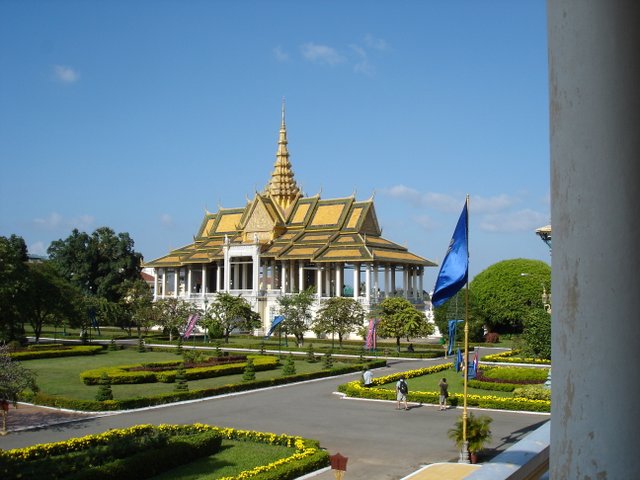 |
| Phnom Penh – palaces and pagodas. |
November 11
The next morning we caught a tuk-tuk to the Tuolsleng Genocide Museum. Originally a school in a residential neighborhood of Phnom Penh, it was converted in 1975 to a “detention and interrogation” facility called S-21 by the Khmer Rouge during the Pol Pot regime. Thousands of Cambodian citizens were incarcerated here, and then systematically tortured to extract a confession of their crimes against the regime. After that they were taken, along with their entire family, to an area outside of the city that has come to be known as the “Killing Fields,” where they were brutally murdered and buried in mass graves. The museum remains pretty much as it was during the 70’s. On display are the tiny cells, shackles and chains used to restrain prisoners, and the various tools used to torture them. Also on display were many photos of the victims, a few of the regime leaders, and some paintings done by one of the very few survivors depicting gruesome scenes of the treatment inflicted upon anyone who was thought to be opposed to the regime. Perhaps the most gruesome display is a large cabinet with rows of human skulls lined up on its shelves. The War Crimes Museum in Phnom Penh is yet another sad memorial to the atrocities committed by despots and their followers.
November 12
We were up very early and boarded a fast ferry at 0700 bound for Siem Reap. The ferry was quite long, low, and narrow, and had a raised area up near the bow for the driver. It sort of resembled a 747 without wings. There didn’t appear to be a baggage hold, so all the luggage was lashed to the roof of the ferry. When the skipper fired up the massive diesel engines, the noise made conversation difficult. When he brought the boat up to cruising speed, which must have been about 50 knots, the decibel level reached the point of being almost painful.Five hours of smooth river and lake waters in our wake, and we were in Siem Reap. Before we could even disembark the ferry, industrious tuk-tuk drivers had made their way on board in search of customers. The first guy we saw was a rather professional looking young man who spoke very good English. He agreed to take us to town for a very reasonable price, and along the way gave us a pitch for his brother the driver, to take us to the temples of Angkor Wat. We made a deal and then were dropped off at our guest house, a charming old place called Ivy’s, where we checked in and had lunch in the pub downstairs.
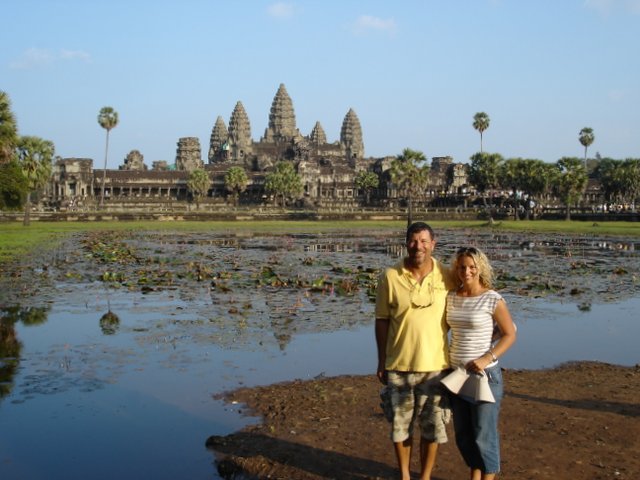 |
| Angkor Wat. |
After lunch, our driver was waiting outside the guest house, and we headed out to see a temple or two. Our first stop was Angkor Wat – the king of all temples and the largest religious structure on the planet. To say that it is magnificent is an understatement. The scale, architecture, and stone carving are all thoroughly impressive. Built in the 12th century, it took 25,000 workers 37 years to complete. Each and every stone had to be carried from a quarry some 50 kilometers away. The stairs, if you can call them that, leading up to the five towers, were so small and rose at such a steep angle that the slightest mishap would probably have proven fatal. I suppose the ancients had to be quite agile to climb these stairways to heaven. Only one had a hand rail that offered any sort of security. That one had a queue that would have lasted till sunset, so we gave the towers a miss. After wandering around the temple for a couple hours appreciating its shadowy hallways, intricate carvings and sheer mass, we had our driver take us to a nearby hill where we experienced a rather average sunset, due to a lot of haze in the air. After being caught in the crowds to get down to the bottom of the hill after sunset, we decided that we would try to do the rest of the temples in the “off peak” hours.
Essentially, the temples around Siem Reap are a case of one-upmanship gone mad. Each emperor throughout Cambodian history attempted to build a bigger and grander temple than his predecessor. While all this temple building may have been a drain on the economy in its day, it certainly is paying off nowadays. The temples of Angkor attract a million visitors annually, paying $20 per day admission, or 3 days for $40, which by the way is equal to an average month’s wages in Cambodia. Most visitors opt for the three-day package. If you do the math, it’s pretty impressive annual turnover. Considering that much of the tab for restoration to the temples is being picked up by foreign groups, it becomes even more impressive. Buddha only knows where all the money goes.
While Siem Reap is a small town, it certainly is lively. Just a couple of blocks from our guest house was the “bar street” which is a two block stretch lined with pubs, restaurants, cafes and night clubs. After the temples shut down for the day, there’s nothing else for tourists to do but eat and drink, so it becomes happy hour all night long! We found an excellent little Indian restaurant for dinner down a lovely side alley.
November 13
After breakfast, our trusty driver was waiting for us, so we hopped into our tuk-tuk and were off to see more temples. There are literally hundreds of temples spread out in an area of about 40 square miles around Siem Reap. If one wanted to seem them all, it would probably take weeks to make the rounds. We started in the fortified city of Angkor Thom at the Bayon, famous for its numerous towers carved with faces in an amazing likeness to its King, and its impressive bas-relief carvings on the surrounding walls depicting life in the day. After four or five temples we were hot, sweaty, sore from climbing the steep stairs, and in sensory overload from all we had seen. We headed back to town to have a late lunch and chill out for the afternoon. We enjoyed a lovely meal of Khmer or Cambodian style cuisine on the Bar Street in town that evening.
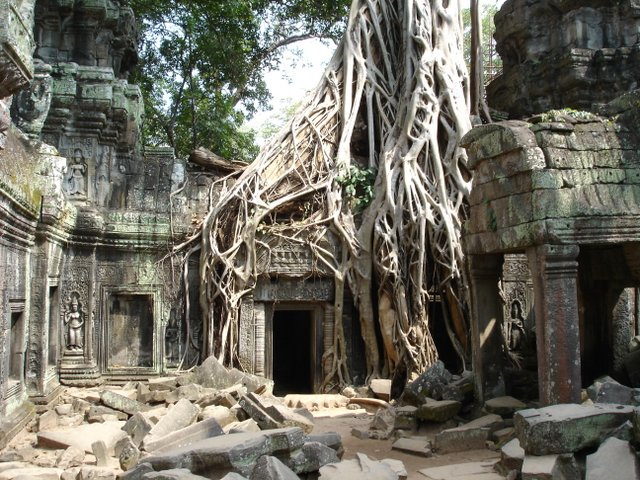 |
| Angkor Thom. |
November 14
Again we were on our way to the temples after breakfast. Two days out there probably would have been enough for all but the hardened archeologist or dedicated tomb raider, but we did enjoy some of the smaller, lesser-restored temples. When the temples of Angkor Wat were originally discovered by the outside world in 1860, most of them were in various states of reclamation by the highly invasive jungle foliage. Some of this can be seen today as trees take root in the temples and their roots force their way though and around the stonework into the jungle floor, distorting and even destroying the massive stone architecture. Crawling through some of these temple sights we had quite a few Indiana Jones and the Temple of Doom and Tomb Raider moments, expecting Angelina Jolie or Harrison Ford to be lurking in the steamy jungle shadows. By early afternoon we were thoroughly “templed out” and satisfied that we had seen enough of Angkor Wat, so we headed back to town for the last time. That evening we had another excellent Khmer meal on the lovely little side alley.
November 15
We departed Cambodia on a Bangkok Air Flight to Bangkok. We chilled out in Bangkok for three days. Flights from Bangkok direct to Langkawi would have cost about US $650 for the two of us, so we instead purchased tickets on Thai Air Asia to Penang for about $89 for two.
November 18
We caught a late afternoon flight from Bangkok to Penang. In all our years of flying, we’ve never experienced a harder landing, if you could call it that, than we made in perfectly calm air in Penang. My bag was actually damaged, probably as a result of this. We hopped a ride to the hotel, dropped off our gear, and immediately headed straight to the classic old Eastern and Oriental Hotel for their excellent Saturday night buffet dinner. As usual, the variety and quality of food was incredible, the free-flow wine just fine and the music of the wandering Malaysian mariachi band, excellent.
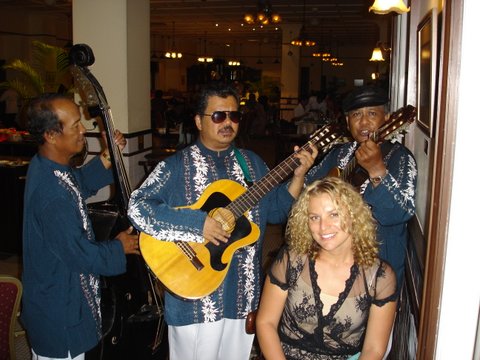 |
| Merima is serenaded by the Malaysian mariachi band. |
November 19
We were up early and after breakfast caught the 0830 ferry from Penang to Langkawi. This was another one of those wingless 747 jobs, but a bit less noisy. In two and a half hours we were back on Langkawi. After five weeks of living out of a suitcase, it was great to be back home aboard Moonshadow.

